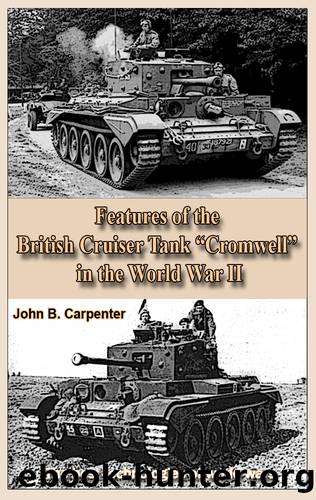Features of the British Cruiser Tank “Cromwell” in the World War II: The best technologies of world wars by Carpenter John B

Author:Carpenter, John B. [Carpenter, John B.]
Language: eng
Format: epub
Published: 2020-08-07T16:00:00+00:00
The program for the modernization of the cruiser tank Cromwell
Since the end of 1943 - in connection with the re-equipping of thousands of tanks by both Centaur and Cromwell with a 75 mm gun, and also in connection with the replacement of Liberty motors with Meteor engines and the need to implement many later design improvements and individual A27 mechanisms - almost all machines of both types. In the original version, by the end of the war, only single copies remained.
Not only tanks that arrived for overhaul from training units and landfills were upgraded, but also completely new machines with a small mileage coming from storage facilities of the mobilization reserve. The order of modernization (replacement of weapons, engines and units) was arbitrary, which led to a variety of types of modernized machines. In the process of development and improvement of design, as well as modernization in 1943-1945. The following models and versions of the Cromwell tank appeared:
Cromwell I - the first production version. The shells of 30 cars were made of cemented steel and armed with a 6-pound cannon OQF. Cromwell IA tanks had a body identical to the Centaur I machines (sometimes called "type C"). Serial production at BRCW enterprises began in February 1943. Originally, the tank received the designation Cromwell III in accordance with the system, according to which all new tanks were called Cromwell. In November the names were changed:
Cavalier (A24) - former Cromwell I and Centaur (A27L) - former Cromwell II. Most tanks of this type, originally training, were later reworked in models V, VI, VII, VIII;
Cromwell II - an experimental version of the tank received a track 15.5 "wide (394 mm) against 14" (355 mm) from the previous model. In addition, on Cromwell II was shot course 7.92-mm machine gun Besa Mk.II. The number of crew members was reduced to 4 people. A total of 16 machines of this modification were built;
Cromwell III - this was the name for the Centaur I tanks with a 75 mm gun, on which the Liberty motors were replaced by Meteor. Originally converted machines were called Cromwell X. The hull is "type D". The model was used exclusively for educational purposes, and then upgraded as modifications of IV, VI, VII, VIII;
Cromwell IV and IVw are the first basic model armed with a 75 mm cannon. This tank was produced in two versions: either the car was built as Cromwell (re-equipped model I-III or originally with a new gun), or - a modernized Centaur III with the "type D" body. This last option was the most numerous and formed the basis of the armament of the allied armored units in the first phase of the battles on the continent in the summer of 1944. Cromwell IVw-machines with welded hull "type F";
Cromwell V and Vw are identical to the "IVw" modification tanks. When assembling, only welding was used (on Mk.IV and IVw some of the elements were assembled on bolts). The lower part of the control section is cast. The machines of modification V were also designated Vw (welded - welded).
Download
This site does not store any files on its server. We only index and link to content provided by other sites. Please contact the content providers to delete copyright contents if any and email us, we'll remove relevant links or contents immediately.
| Africa | Americas |
| Arctic & Antarctica | Asia |
| Australia & Oceania | Europe |
| Middle East | Russia |
| United States | World |
| Ancient Civilizations | Military |
| Historical Study & Educational Resources |
Magic and Divination in Early Islam by Emilie Savage-Smith;(1500)
Ambition and Desire: The Dangerous Life of Josephine Bonaparte by Kate Williams(1345)
Bohemians, Bootleggers, Flappers, and Swells: The Best of Early Vanity Fair by Bohemians Bootleggers Flappers & Swells- The Best of Early Vanity Fair (epub)(1344)
Papillon by Henry Charrière(1310)
Twelve Caesars by Mary Beard(1256)
Operation Vengeance: The Astonishing Aerial Ambush That Changed World War II by Dan Hampton(1137)
What Really Happened: The Death of Hitler by Robert J. Hutchinson(1130)
London in the Twentieth Century by Jerry White(1114)
Time of the Magicians by Wolfram Eilenberger(1089)
The Japanese by Christopher Harding(1086)
Twilight of the Gods by Ian W. Toll(1084)
Lenin: A Biography by Robert Service(1045)
The Devil You Know by Charles M. Blow(985)
A Social History of the Media by Peter Burke & Peter Burke(936)
Freemasons for Dummies by Hodapp Christopher;(923)
Napolean Hill Collection by Napoleon Hill(903)
Henry III by David Carpenter;(892)
The Churchill Complex by Ian Buruma(884)
The Rise and Triumph of the Modern Self by Unknown(880)
